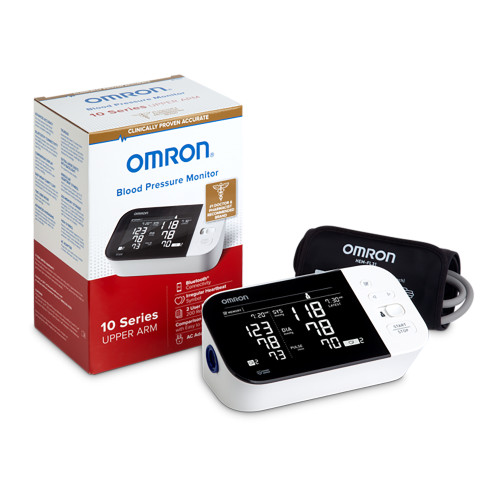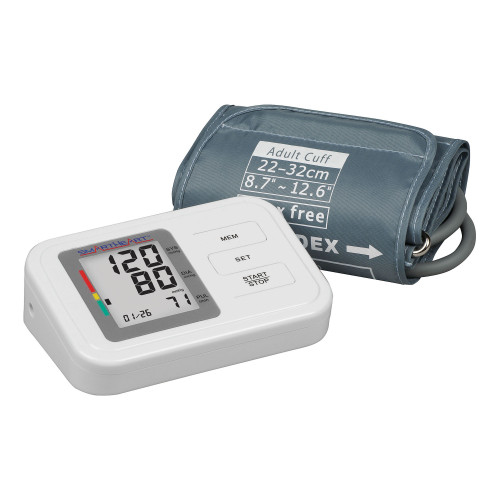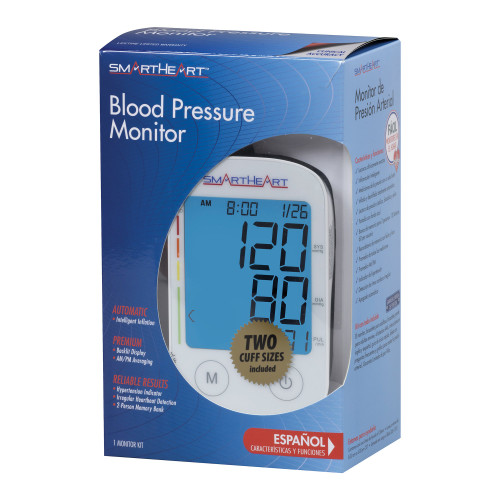-

Mabis
MABISLegacy Adult Cuff Arm Aneroid Sphygmomanometer Unit
This sphygmomanometer features an easy squeeze inflation bulb that comfortably fits in your hand. The aneroid gauge shows large easy-to-read numbers, perfect for those with poor vision. You will enjoy its manual design to gain accurate results.The...
$33.57 -

Mabis
HealthSmart Blood Pressure Monitor - Automatic Digital Monitoring - Wrist
Take vital readings at home or while traveling with the Mabis® HealthSmart® Premium Series Digital Blood Pressure Monitor. It fits snugly in place with a wrist cuff, and is conveniently cordless and portable. After taking a reading, the Mabis® digital...
$45.37 -

Omron 10 Series
Omron 10 Series Wide Range Arm Home Automatic Digital Blood Pressure Monitor
Omron Seven Series Upper Arm Blood Pressure Monitor offers a horizontally designed dual-display monitor and stores up to one hundred twenty readings - sixty readings per each of two users and includes a pre-formed easy wrap comFit cuff.Adult large cuff...
$97.48 -

Omron7 Series
Omron7 Series One Size Fits Most Cuff Wrist Home Automatic Digital Blood Pressure Monitor
Keep track of your health with the 7 Series Wireless Wrist Blood Pressure Monitor. It has a lightweight and slim design to make it easy to take with you while traveling. The monitor fits wrist circumferences ranging from 5.3 inches to 8.5 inches, making...
$78.86 -

Beurer
Beurer Adult Cuff Arm Digital Blood Pressure Monitor
4 x 30 memory space Classification of color chart / XL LCD Display Incorrect Usage message / Auto switch-off Universal Cuff circumference 8.7"-16.5" Blue illuminated Start/Stop button Monitoring with Beurer HealthCoach App / Bluetooth Upper arm blood...
As low as $76.77 -

SmartHeart
Smartheart Adult Cuff Arm Digital Blood Pressure Monitor
Clinically accurate readings Blue backlit display Fully automatic inflation and deflation Systolic, diastolic and pulse results 2-person memory bank holds 500-readings, 250 per user Memory recall with date/time stamp Average of last 3 readings...
As low as $48.02 -

SmartHeart
Smartheart Adult Cuff Arm Home Automatic Digital Blood Pressure Monitor
SmartHeart Home Automatic Digital Blood Pressure Monitor features advanced inflation. Measurement is taken on the inflation, meaning less time with the cuff constricted on the arm for a more comfortable experience overall. This monitor provides systolic,...
As low as $40.34 -

A&D Medical
A&D Medical Wide Range Arm Home Automatic Digital Blood Pressure Monitor
The A&D Essential Wide Range Cuff is a classic blood pressure monitor with the benefits of speed and accuracy at the push of a button. It has the ability to indicate irregular heartbeat during a measurement. This trusted blood pressure monitor classifies...
$35.28 -

McKesson
McKesson LUMEON Bulbs / Valves / Bladders Blood Pressure Inflation Bulb
2-year warranty For use with most Aneroid Sphygmomanometers Filter screen end valve included Deluxe black bulb
$11.97 -

Clever Choice
Clever Choice Digital Blood Pressure Monitor, Large Arm, Adult
Adult size - 22 to 42 cm Navy Digital display with AC adapter or battery operated power source
$44.90 -

McKesson
McKesson LUMEON Child Arm Aneroid Sphygmomanometer Unit, Green, Reusable
Inflation bladder and bulb Filter screen valves reduce dust buildup Luminescent dial and extended graduation marks for easy reading in all light conditions and from virtually any angle Color: Green Heavily chrome-plated, precision-crafted 300 mm Hg...
$34.59 -

Veridian
Veridian SmartHeart Blood Pressure Monitor with Large/XL Arm Cuffs
The SmartHeart™ Automatic Digital Blood Pressure Arm Monitor features automatic inflation and deflation and returns systolic, diastolic and pulse results. Intelligent inflation utilizes results history during measurement to determine inflation level,...
As low as $61.15
Blood Pressure Units

Blood Pressure Units
In many chronic conditions like hypertension, diabetes, and kidney diseases, accurate blood pressure measurement is extremely important. Monitoring your blood pressure at home using a blood pressure unit provides valuable information about your health.
What Are Blood Pressure Units?
Blood pressure units are automatic blood pressure monitors used in health care facilities or at home. They consist of a wrist or arm cuff and a digital monitor. Unlike manual blood pressure cuffs, they work at a touch of a button and display the reading on the LCD. In addition, the device measures your heart rate and can catch irregular heartbeats.
How Do They Work?
Just like regular blood pressure cuffs, blood pressure units measure your systolic and diastolic blood pressures. Systolic blood pressure measures the force of blood as it moves through the arteries to the rest of the body. The bottom figure, diastolic blood pressure, measures the force your heart produces on the walls of your arteries between beats.
When the cuff records your systolic and diastolic pressures, it creates vibrations detected by the blood pressure reader, which are then displayed on the LCD display.
Types of Blood Pressure Units
Arm Blood Pressure Units
Digital arm blood pressure monitors allow for easy and accurate blood pressure measurement. In addition, they have portable monitors and are slim and discrete for convenience.
When looking for a suitable blood pressure unit, find one with the appropriate cuff size, and make sure you're not allergic to any of the materials.
You can also look for units that provide more health information aside from the systolic and diastolic blood pressures. For example, some units also read pulse rate, time of the day, and date.
This information, coupled with the expanded memory storage, will allow you to review your previous readings with a touch of a button. This can come in handy when updating your doctor or tracking blood pressure spikes or dips throughout the day.
Wrist Blood Pressure Units
Wrist blood pressure units work the same way, except that you wrap the cuff around your wrist instead of your arm. When looking for a wrist blood pressure unit, check the information you can obtain from the device and its maximum storage. That will give you an idea of how many readings it can hold.
Double Check the Instructions
Whether you choose an arm or wrist cuff monitor, ensure it has a complete and easy-to-follow guide. Blood pressure device readings tend to be easily affected by several factors, including human errors and body positions.
Pay Attention to Cuff Size
The size of the cuff is essential for both an arm or wrist unit. They come in pediatric, adult, and bariatric sizes. Choosing the right one for your needs will ensure a more accurate reading.
With digital blood pressure units, you can measure your blood pressure anytime, anywhere, even when you're on vacation, so that you can be an active member of your healthcare team.
In many chronic conditions like hypertension, diabetes, and kidney diseases, accurate blood pressure measurement is extremely important. Monitoring your blood pressure at home using a blood pressure unit provides valuable information about your health.
What Are Blood Pressure Units?
Blood pressure units are automatic blood pressure monitors used in health care facilities or at home. They consist of a wrist or arm cuff and a digital monitor. Unlike manual blood pressure cuffs, they work at a touch of a button and display the reading on the LCD. In addition, the device measures your heart rate and can catch irregular heartbeats.
How Do They Work?
Just like regular blood pressure cuffs, blood pressure units measure your systolic and diastolic blood pressures. Systolic blood pressure measures the force of blood as it moves through the arteries to the rest of the body. The bottom figure, diastolic blood pressure, measures the force your heart produces on the walls of your arteries between beats.
When the cuff records your systolic and diastolic pressures, it creates vibrations detected by the blood pressure reader, which are then displayed on the LCD display.
Types of Blood Pressure Units
Arm Blood Pressure Units
Digital arm blood pressure monitors allow for easy and accurate blood pressure measurement. In addition, they have portable monitors and are slim and discrete for convenience.
When looking for a suitable blood pressure unit, find one with the appropriate cuff size, and make sure you're not allergic to any of the materials.
You can also look for units that provide more health information aside from the systolic and diastolic blood pressures. For example, some units also read pulse rate, time of the day, and date.
This information, coupled with the expanded memory storage, will allow you to review your previous readings with a touch of a button. This can come in handy when updating your doctor or tracking blood pressure spikes or dips throughout the day.
Wrist Blood Pressure Units
Wrist blood pressure units work the same way, except that you wrap the cuff around your wrist instead of your arm. When looking for a wrist blood pressure unit, check the information you can obtain from the device and its maximum storage. That will give you an idea of how many readings it can hold.
Double Check the Instructions
Whether you choose an arm or wrist cuff monitor, ensure it has a complete and easy-to-follow guide. Blood pressure device readings tend to be easily affected by several factors, including human errors and body positions.
Pay Attention to Cuff Size
The size of the cuff is essential for both an arm or wrist unit. They come in pediatric, adult, and bariatric sizes. Choosing the right one for your needs will ensure a more accurate reading.
With digital blood pressure units, you can measure your blood pressure anytime, anywhere, even when you're on vacation, so that you can be an active member of your healthcare team.
